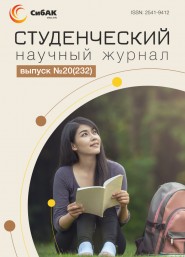Статья опубликована в рамках: Научного журнала «Студенческий» № 20(232)
Рубрика журнала: Математика
Скачать книгу(-и): скачать журнал часть 1, скачать журнал часть 2, скачать журнал часть 3, скачать журнал часть 4, скачать журнал часть 5, скачать журнал часть 6, скачать журнал часть 7, скачать журнал часть 8, скачать журнал часть 9, скачать журнал часть 10, скачать журнал часть 11, скачать журнал часть 12, скачать журнал часть 13
NONCOMMUTATIVE GROUPS ANNOTATION
ABSTRACT
The article considers noncommutative groups.
Keywords: noncommutative groups.
Purpose: to study the concept of a noncommutative group, to consider examples of noncommutative groups in problems.
Tasks:
1. To study the literature on this topic;
2. Analyze the received material;
3. Solve problems
4. Make a conclusion
A noncommutative group, also known as a non–Abelian group![]() , is a group in which there exists at least one pair of elements a and b of group G such that
, is a group in which there exists at least one pair of elements a and b of group G such that![]() . This class of groups is contrasting with respect to Abelian groups, in which all pairs of group elements commute.
. This class of groups is contrasting with respect to Abelian groups, in which all pairs of group elements commute.
Nowadays, noncommutative groups are often found in mathematics and physics. An example of a non-Abelian group is the dihedron group of order 6. It is the smallest finite non-Abelian group.
A square matrix A is called non-degenerate if the determinant ![]() not equal to zero:
not equal to zero: ![]() . Otherwise, the matrix A is called degenerate.
. Otherwise, the matrix A is called degenerate.
The theorem. Every non-degenerate matrix has an inverse.
We present a proof for the case of a matrix of the 3rd order. Let
 with what
with what ![]() .
.
Consider a square matrix A’, called the union matrix, whose elements are algebraic complements of the element aij of the given matrix A (defined in the same way as the algebraic complement of the determinant element).

And we will find the product A by A’.
 =
=

Using the properties of matrix operators, we obtain:
=
Similarly, it can be shown that ![]()
1. Let's consider typical tasks on this topic.
Make up some third-order substitution ![]() and find
and find ![]() . How else can this substitution be set? Will this substitution be even?
. How else can this substitution be set? Will this substitution be even?
Decision. Third-order substitutions are any one-to-one (bijective) mapping of the set of the first 3 natural numbers onto itself. Let![]()
![]() .
.
This entry indicates that ![]() =3. The substitution will remain equal to itself if it is written by swapping the columns, so you can set the substitution
=3. The substitution will remain equal to itself if it is written by swapping the columns, so you can set the substitution ![]() even so
even so
 .
.
The parity of the substitution is determined by the parity of the substitution in its second row (if we consider the option when all the numbers in the first row are arranged in ascending order. Let's count the total number of inversions in the substitution 2, 3, 1. The number 2 forms an inversion with the number 1 and the number 3 forms an inversion with 1. The result is that there are only 2 inversions in this permutation, so it is even, and therefore a substitution ![]()
Answer: ![]() one of the substitutions of the 4th degree. It is even, since the total number of inversions for it is 2.
one of the substitutions of the 4th degree. It is even, since the total number of inversions for it is 2.
2. Make a substitution ![]() if
if ![]() . What is the parity of this substitution?
. What is the parity of this substitution?
Decision. Once the bijective mapping of the first four numbers to itself is given, then this is the substitution
![]() . It is said that this substitution translates the number 1 in 4
. It is said that this substitution translates the number 1 in 4 ![]() ), number 2 in 3 (2
), number 2 in 3 (2![]() , number 3 in 1 (3
, number 3 in 1 (3![]() , number 4 in 2 (4
, number 4 in 2 (4![]()
Let's count the number of inversions in the bottom row of the substitution ![]() .
.
4 forms 3 inversions with all the other numbers, 3 – two inversions and 2 does not form an inversion with two, and 2 is in last place. The total number of inversions is 5. Therefore, the substitution is odd.
Answer: Substitution![]() is odd.
is odd.
Conclusion: a noncommutative group is a group in which there exists at least one pair of elements a and b of group G, such that ![]() . In the article, an example of a noncommutative group was considered, and the solution of problems was also given.
. In the article, an example of a noncommutative group was considered, and the solution of problems was also given.
References:
- Aminov L.K. Group theory and its applications. Lecture notes and tasks / L.K. Aminov, A.S. Kutuzov, Yu.N. Proshin. – Kazan: University, 2015. – 123 p.
- Belonogov, V. A. Taskbook on group theory. / V.A. Belonogov. – M., Nauka, 2000. – 239 p.
- Bogopolsky, O. V. Introduction to the theory of groups. / O.V. Bogopolsky. – Moscow–Izhevsk, 2002. – 148 p.
- Vinberg, E. B. Course of algebra. : 3rd ed., reprint. and additional /E.B.Vinberg. – M.: Factorial Press, 2002. – 544 p.
- Kargapolov, M. And Fundamentals of group theory. / M. I. Kargapolov, Yu. I. Merzlyakov –M.: Nauka, 1982. — 205 p.


Оставить комментарий